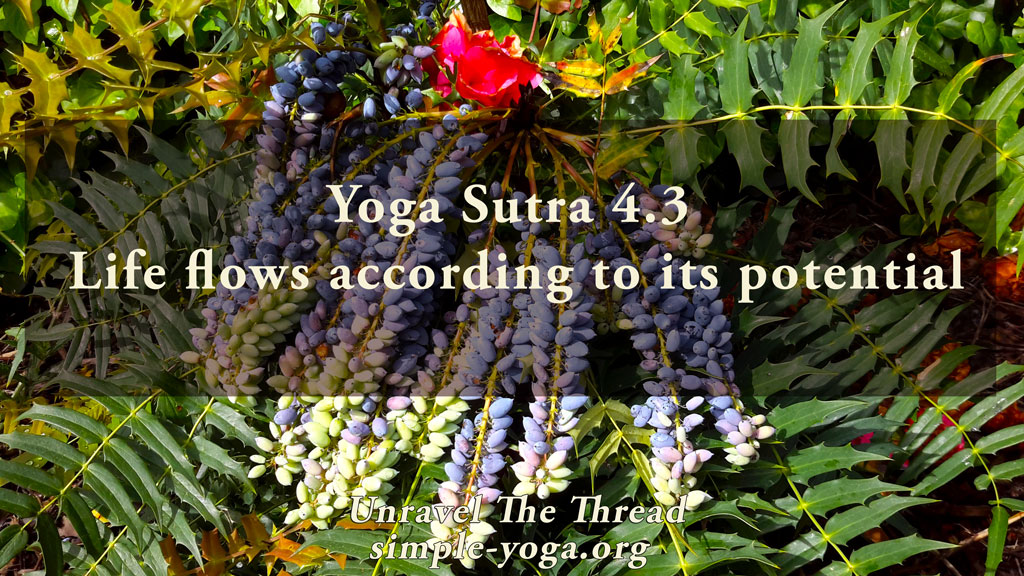
4.2 Being is nature flowing
June 10, 2022
4.4 Created minds from sense of self
July 6, 2022
4.2 Being is nature flowing
June 10, 2022
4.4 Created minds from sense of self
July 6, 20224.3 Life flows according to its potential

4.3 The flow of life in nature (prakriti) is not the result of incidental causes. When obstacles are removed, life flows organically according to its own potentiality.
Continuing the line of thought in the previous sutra, this aphorism acts as a reminder that nature has its own primordial tendencies. Your previous actions do not cause your life; your previous actions, however, will influence your birth, lifespan, and quality of experiences (2.13). When obstacles are removed, life flows according to its own potentiality, like when a farmer diverts the flow of water from one field to another to irrigate the field that needs it. The farmer does not actually cause the water to be absorbed by the plants that need it. Instead, the farmer creates the conditions conducive for water to be absorbed, which happens according to the nature of water, soil, the ecosystem of bacteria in the soil, and the plant root system. If you have ever tried to plant a garden, you may have noticed that you start by removing weeds, preparing the soil and planting the seeds appropriate to your geographic location, season, and sun exposure. Even when you prepare the whole section evenly and you use seeds from the same seed bank, you will notice that some seeds germinate, and some seeds don’t. In other words, you orchestrate the incidental causes, creating propitious conditions for your plants to grow, but you have no control of how nature will manifest. These incidental causes that you manipulate are not the cause of life flowing into the seeds to germinate them.
The second half of this sutra presents the part that is within your control, removing the obstacles to the flow of life. You do this by amending the soil, removing weeds, ensuring that it is the right season and correct sun exposure. Although some seeds may have a chance to grow even when you do not prepare the ground, probabilities increase dramatically when you facilitate the process by removing the obstructions to the flow of life in nature.
Remember the definition and results of yoga in Chapter One of the Yoga Sutra, that yoga is regulating your ways of being (1.2). This regulation is precisely the removal of obstacles explained in this sutra. Because of regulating your ways of being, you embody your true nature (1.3). To embody your true nature is to live in what is often called the natural state. This point is reiterated here because it is crucial to yoga practice. The natural state is your birthright, it is the effortless joy and health you witness in a baby. You look at the baby and it looks back at you with a genuine smile and a carefree attitude. There is no effort on the baby’s part to abide in the natural state; that is why it is called the natural state. It happens often that we come to see yoga as a system to acquire, fitness, health, beauty, or extraordinary strength or flexibility. When that happens, we set up inaccurate goals for the practice. At the same time, these goals generate expectations that will become the seeds of future frustrations, because even when you attain them, they will be temporary.
Yoga is a complete system to remove the obstacles that keep you from being in your natural state of effortless joy. That’s why the first step is to become aware of what you are doing. Next, you decide how what you are doing is contributing to keep you in your natural state. You remove the unhelpful ways of being, the obstacles preventing you from living unconditionally.
Is there a difference between your normal state and your natural state?
How are you aligning with your natural state?
Are there any obstructions limiting your access to the joy and love permeating your being?
How many of those obstacles can you learn to regulate and, eventually, remove?
As usual, one more way of exploring the meaning of this sutra is by chanting it.
You can choose to chant it in its traditional form with some of the words coming together:
4.3 nimittamaprayojakaṃ prakṛtīnāṃvaraṇabhedastu tataḥ kṣetrikavat
निमित्तमप्रयोजकं प्रकृतीनांवरणभेदस्तु ततः क्षेत्रिकवत् ॥३॥
Another option is to chant each word in the sutra individually:
- nimittam
- aprayojakaṃ
- prakṛtīnāṃ
- varaṇa
- bhedaḥ
- tu
- tataḥ
- kṣetrikavat
If you prefer, you may listen to the podcast:
This is an excerpt from the book Unravel the thread: Applying the ancient wisdom of yoga to live a happy life
If you find Simple-Yoga.org and Unravel the thread useful, consider supporting my labor with a donation, you may also donate using PayPal or Venmo. Thank you!
